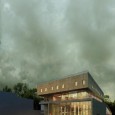
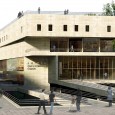
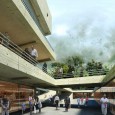
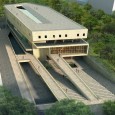
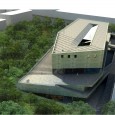
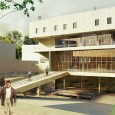
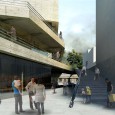
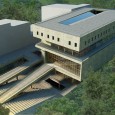
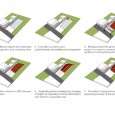
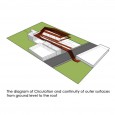
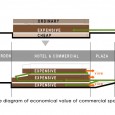
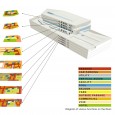
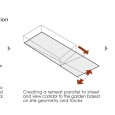
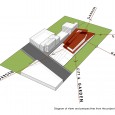
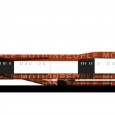
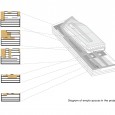
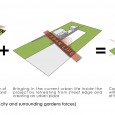
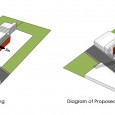
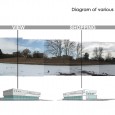
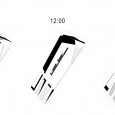
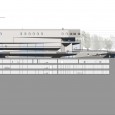
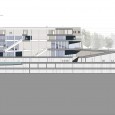
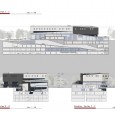
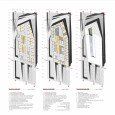
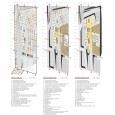


PROJECT GENERAL INFORMATION
Name: Amiran Hotel & Commercial Center
Location: Nishapur, Khorasan Razavi, Iran
Architecture Firms: Hajizadeh & Associates + Bam Citadel of Kerman Consulting Engineers [→]
Architect in Charge: Kourosh Hajizadeh
Design Associates: Kourosh Hajizadeh, Ali Ghorbani, Arezoo Izadyari
Project Manager: Shahabeddin Arfaei
Date of Design: 2011
Total Area: 4702.3 sqm
Building Type: Hotel, Commercial
3D Modeling and Rendering: Saeid Fahimpour, Mehdi Saleh
Status: 3rd Place
Awards: Shortlisted in the section of Hospitality project of the year in the Middle East Awards - 2014
Nishapur is one of the most important cities of north-east of Iran that has the precious treasure of history and national and global fame because of its mythical and eventful presence in old history of Iran, having long and brilliant background in Persian civilization and culture, locating on the Silk Road and the main connecting road, having excellent natural situation such as high mountains, rivers with high water flow, mountainous valleys and country sides. With no doubt, Nishapur is one of the most famous centers for Iranian and Islamic civilization and in both “Iranian” and “Islamic” opportunity and situation, it has been the origin of many magnificent cultural achievements. Nowadays because of some brilliant historic works and background including tombs of important poets such as “Khayyam”, “Attar” and an important painter like “Kamal ol-molk” and its proximity to city of Mashhad has provided a considerable capacity for developing the tourism industry. This city has been named “sustainable Iranian city” by UNESCO.
The total area of the project site is 4702.3 m² and is located on the edge of Imam Khomeini Street with one meter retreating from the edge of the street and is adjacent to historical gardens (Aminol Islami and Ghavami gardens). One of the most important aims and strategies of designing this project was to consider the adjacency of precious historical gardens and their influence on the project and also the impact of the project on these gardens, so this strategy could increase the cultural values of the space.
Normally, commercial spaces in lower levels from street level have low economic value and have inappropriate space than other parts. In addition to this, height limit of 16m caused problem in expansion of space in higher levels. By getting down from street edge through stairs with gentle slope this limitation was used and a proper space with connection with Godal Baghche yards was created for the lower commercial units so they can have the same value as upper commercial units. In addition to proper access of these stairs to commercial spaces, they provide view from the street to these spaces and vice versa and also create platforms for sitting and create an urban space.
Connection of this floor (level-4.00) with national garden through a subway has increased the value of these spaces. The value of upper floors commercial units (level +3.5) are increased by creation of access stairs in open and closed spaces between various floors. Circulation routes on the edge of the building on different floors which are connected to historical gardens and the city, and also the central void increases the value of whole commercial spaces and introduce the complex to the city as an attractive and lively atmosphere.
For creating an urban plaza, the retreating on the edge of the land is parallel to Imam Khomeini Street .The view corridor to the garden from the edge of the street was also formed by an angled cut in the volume, moreover moving toward the garden created an inviting and multi dimensional view from the building. The transformation is caused by geometry and forces of site and led to more connection of site with its surrounding.
For organizing various functions of the project, the overall geometry of the project and central void were used. The central void provides the possibility for visual communication between floors and between the escalator and different levels. The roof of the void is made of glass and its side walls are made of copper in order to create more attractive inner spaces and let more light in to the inner spaces. So the void is connected to a copper wall all through its height and also is connected to various spaces through other three sides.
- Flexible interaction of building façade with city and surroundings.
The outer crust of the building reflects its functions and inner incidents which introduce characteristics and inner life of each part of the building to the city and connect its outside to its inside. This is done by transparent façade and bringing out some of its internal space functions.So, people walk on the edge of the project and this motion forms some parts of the façade.
People move on the edge of the building gives an attractive and vibrant character to the building. This feature changes during days and different seasons of the year and with coordination of the commercial spaces window which is another characteristic of building’s façade, give a flexible and divergent property to the building. flowing routes on outer edge of the building go around the building and create various spatial quality in different points.
From one side, these surrounding routes connect historical gardens around the project and from the other side they connect to the city and while passing along commercial spaces, this two strong elements of site ( garden and the city) are joined.Therefore, main elements of building façade are people’s motion on the edge of the building and the window of commercial spaces. elements which are changeable and flexible over time and various seasons can change the quality of façade with their change.
Location of the project beside Imam Khomeini Street as the main backbone and most important artery of the city from one hand and historical gardens surrounding the site has given a particular character to the project.Connection with the city and creating an open urban space in the heart of the project has been one of the most important aims of the design. This aim was achieved by retreating from street edge and bringing in urban life inside the project.
On the other side, connection of old gardens with city and with each other is a fact that can join urban life to surrounding nature.The combination of these two forces, bringing of urban life and connection with historical gardens and the city can led to the idea of locating the bulks. On the way to the building and internal motions it was tried to create an attractive building with high spatial variation by using the void and surrounding open spaces. This spatial variation helps the high value and transparent internal connection of all spaces and strengthens the building connection with outside.
Inappropriate walls of buildings on western side of the project can become a factor for more efficiency of the design and creates a better spatial quality for the view corridor to Ghavami garden.With 3 meters retreating from street edge, broaden of the alley will be possible. The space underneath these3 meters retreating is used as commercial space so it creates a mutual benefit.
By considering the northern- southern elongation of the land from street to surrounding gardens, various domains for current activities in building are created. The boundary of Imam Khomeini Street is retreating of the volume that creates an urban plaza and is a context for incidence of public events. On the next layer of commercial spaces and other functions we reach to a stage with 3.5 meter height which is a place for watching surrounding gardens and provide connection between the project and the garden.
- Design features
- Retreating from street edge in order to create an open urban space.
- Decreasing functional level of yard in order to increase spatial and economical value of commercial parts under the ground level and using this level for connection of building to surrounding gardens.
- Connection with national garden through subway and expansion of commercial spaces of level -4 in this path.
- Creating pedestrian path on the edge of the building and on different levels in order to create various views and perspectives to the city and the garden and introducing buildings current life to its surrounding.
- Connecting different floors through central void which continues from level -1 to the roof.
- Considering fifth façade of the project and using roof as a lively space serving the hotel for watching surroundings.
- Influence of street axis on the form of the building in order to create various and attractive views and to define a path ending to back gardens.
- 3 meter retreating from the edge of the alley and using its beneath as commercial use.
- Prevision of connecting the building with Ghavami garden in long term process through proper organization of plan and creation of a glass wall facing the garden.







